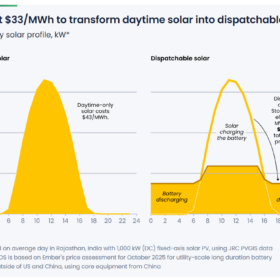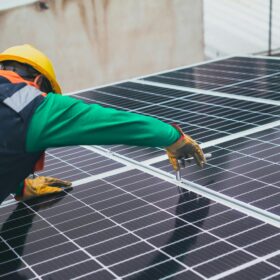A research team from Stanford University has developed a prototype that uses solar energy to extract nutrients from human urine to create a sustainable fertilizer.
They presented the system in “Prototyping and modelling a photovoltaic–thermal electrochemical stripping system for distributed urine nitrogen recovery,” available in the research journal Nature Water.
The prototype uses solar energy via a photovoltaic-thermal electrochemical stripping system to capture nitrogen, a key component of commercial fertilizers, from human water waste. The nitrogen in human urine globally is equivalent to about 14% of annual fertilizer demand.
The researchers said in a statement that the system separates ammonia, a chemical compound made up of nitrogen and hydrogen, from urine. This is done via a series of chambers separated by membranes that use solar electricity to drive ions across and trap the ammonia as ammonium sulfate, a common fertilizer.
The researchers collected waste heat from the back of solar panels via an attached copper tube cold plate to warm the liquid used in the electrochemical process. They found this helped to speed up the warming and encouraged ammonia gas production, the final step in the separation process.
Utilizing waste heat from solar panels was found to increase their power generation by nearly 60% while improving ammonia recovery efficiency by more than 20%, compared to earlier prototypes.
Orisa Coombs, lead author of the study, explained that despite each person producing enough nitrogen in their urine to fertilize a garden, much of the world is reliant on expensive, imported fertilizers. “You don’t need a giant chemical plant or even a wall socket,” Coombs added. “With enough sunshine, you can produce fertilizer right where it’s needed, and potentially even store or sell excess electricity.”
The research also features a model designed to understand how changes in sunlight, temperature and electrical configuration would impact the system’s performance.
It found that in regions such as Uganda the prototype system could generate up to $4.13/kg of nitrogen recovered, more than double the potential earnings in the United States. This helped the researchers to conclude that their system is a viable, cost-effective alternative to traditional fertilizers, particularly in areas where access to agricultural inputs is limited and where fertilizer remains expensive.
Stanford University said that removing nitrogen from urine makes the remaining liquid safer to discharge or reuse for irrigation, which it adds can be a “game changer in many countries where only a small percentage of the population is connected to centralized sewage systems”.
“We often think of water, food, and energy as completely separate systems, but this is one of those rare cases where engineering innovation can help solve multiple problems at once,” said Coombs. “It’s clean, it’s scalable, and it’s literally powered by the sun.”
This content is protected by copyright and may not be reused. If you want to cooperate with us and would like to reuse some of our content, please contact: editors@pv-magazine.com.








By submitting this form you agree to pv magazine using your data for the purposes of publishing your comment.
Your personal data will only be disclosed or otherwise transmitted to third parties for the purposes of spam filtering or if this is necessary for technical maintenance of the website. Any other transfer to third parties will not take place unless this is justified on the basis of applicable data protection regulations or if pv magazine is legally obliged to do so.
You may revoke this consent at any time with effect for the future, in which case your personal data will be deleted immediately. Otherwise, your data will be deleted if pv magazine has processed your request or the purpose of data storage is fulfilled.
Further information on data privacy can be found in our Data Protection Policy.